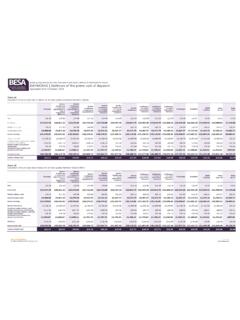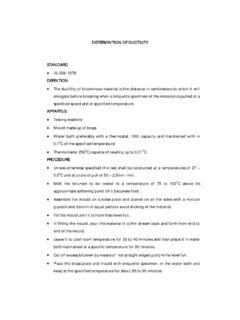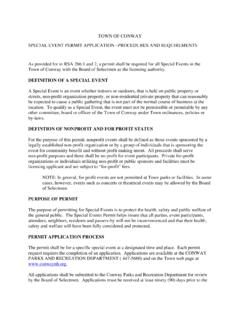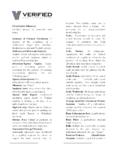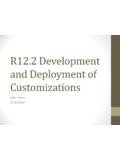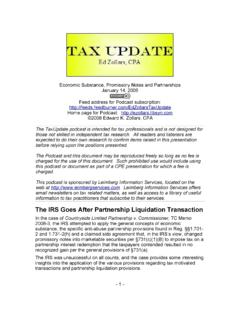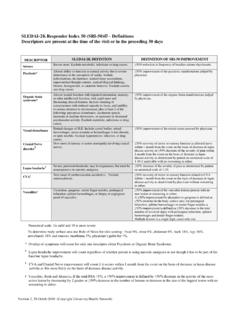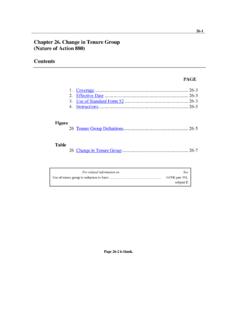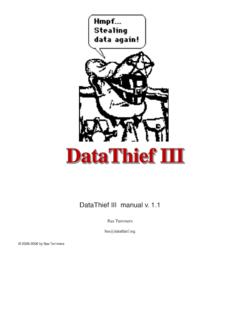Transcription of 2. Noise sources and their measurement - WHO
1 212. Noise sources and their Basic Aspects of Acoustical MeasurementsMost environmental noises can be approximately described by one of several simple are all derived from overall sound pressure levels, the variation of these levels with timeand the frequency of the sounds. Ford (1987) gives a more extensive review of variousenvironmental Noise measures. Technical definitions are found in the glossary in Appendix Sound pressure levelThe sound pressure level is a measure of the air vibrations that make up sound. All measuredsound pressures are referenced to a standard pressure that corresponds roughly to the threshold ofhearing at 1 000 Hz. Thus, the sound pressure level indicates how much greater the measuredsound is than this threshold of hearing.
2 Because the human ear can detect a wide range of soundpressure levels (10 102 Pascal (Pa)), they are measured on a logarithmic scale with units ofdecibels (dB). A more technical definition of sound pressure level is found in the sound pressure levels of most noises vary with time. Consequently, in calculating somemeasures of Noise , the instantaneous pressure fluctuations must be integrated over some timeinterval. To approximate the integration time of our hearing system, sound pressure meters havea standard Fast response time, which corresponds to a time constant of s. Thus, allmeasurements of sound pressure levels and their variation over time should be made using theFast response time, to provide sound pressure measurements more representative of humanhearing.
3 Sound pressure meters may also include a Slow response time with a time constant of 1s, but its sole purpose is that one can more easily estimate the average value of rapidlyfluctuating levels. Many modern meters can integrate sound pressures over specified periods andprovide average values. It is not recommended that the Slow response time be used whenintegrating sound pressure meters are sound pressure levels are measured on a logarithmic scale they cannot be added oraveraged arithmetically. For example, adding two sounds of equal pressure levels results in atotal pressure level that is only 3 dB greater than each individual sound pressure , when two sounds are combined the resulting sound pressure level will besignificantly greater than the individual sound levels only if the two sounds have similar pressurelevels.
4 Details for combining sound pressure levels are given in Appendix Frequency and frequency weightingThe unit of frequency is the Hertz (Hz), and it refers to the number of vibrations per second ofthe air in which the sound is propagating. For tonal sounds, frequency is associated with theperception of pitch. For example, orchestras often tune to the frequency of 440 Hz. Mostenvironmental sounds, however, are made up of a complex mix of many different may or may not have discrete frequency components superimposed on Noise with a broad22frequency spectrum ( sound with a broad range of frequencies). The audible frequency rangeis normally considered to range from 20 20 000 Hz.
5 Below 20 Hz we hear individual soundpulses rather than recognizable tones. Hearing sensitivity to higher frequencies decreases withage and exposure to Noise . Thus, 20 000 Hz represents an upper limit of audibility for youngerlisteners with unimpaired hearing systems are not equally sensitive to all sound frequencies (ISO 1987a). Thus, not allfrequencies are perceived as being equally loud at the same sound pressure level, and whencalculating overall environmental Noise ratings it is necessary to consider sounds at somefrequencies as more important than those at other frequencies. Detailed frequency analyses arecommonly performed with standard sets of octave or 1/3 octave bandwidth filters.
6 Alternatively,Fast Fourier Transform techniques or other types of filters can be used to determine the relativestrengths of the various frequency components making up a particular environmental weighting networks provide a simpler approach for weighting the importance ofdifferent frequency components in one single number rating. The A-weighting is mostcommonly used and is intended to approximate the frequency response of our hearing system. Itweights lower frequencies as less important than mid- and higher-frequency sounds. C-weighting is also quite common and is a nearly flat frequency response with the extreme highand low frequencies attenuated. When no frequency analysis is possible, the difference betweenA-weighted and C-weighted levels gives an indication of the amount of low frequency content inthe measured Noise .
7 When the sound has an obvious tonal content, a correction to account forthe additional annoyance may be used (ISO 1987b). Equivalent continuous sound pressure levelAccording to the equal energy principle, the effect of a combination of Noise events is related tothe combined sound energy of those events. Thus, measures such as the equivalent continuoussound pressure level (LAeq,T) sum up the total energy over some time period (T) and give alevel equivalent to the average sound energy over that period. Such average levels are usuallybased on integration of A-weighted levels. Thus LAeq,T is the average energy equivalent levelof the A-weighted sound over a period Individual Noise eventsIt is often desired to measure the maximum level (LAmax) of individual Noise events.
8 For casessuch as the Noise from a single passing vehicle, LAmax values should be measured using theFast response time because it will give a good correlation with the integration of loudness by ourhearing system. However, for very short-duration impulsive sounds it is often desirable tomeasure the instantaneous peak amplitude to assess potential hearing-damage risk. If actualinstantaneous pressure cannot be determined, then a time-integrated peak level with a timeconstant of no more than ms should be used (ISO 1987b). Such peak readings are oftenmade using the C- (or linear) frequency , discrete sound events can be evaluated in terms of their A-weighted soundexposure level (SEL, for defintion see appendix 5).
9 The total amount of sound energy in a23particular event is assessed by the SEL. One can add up the SEL values of individual events tocalculate a LAeq,T over some time period, T, of interest. In some cases the SEL may providemore consistent evaluations of individual Noise events because they are derived from thecomplete history of the event and not just one maximum value. However, A-weighted SELmeasurements have been shown to be inadequate for assessing the (perceived) loudness ofcomplex impulsive sounds, such as those from large and small weapons (Berglund et al. 1986).In contrast, C-weighted SEL values have been found useful for rating impulsive sounds such asgun shots (Vos 1996; Buchta 1996; ISO 1987b).
10 Choice of Noise measureLAeq,T should be used to measure continuing sounds such as road traffic Noise , many types ofindustrial noises and Noise from ventilation systems in buildings. When there are distinct eventsto the Noise such as with aircraft or railway Noise , measures of the individual events should beobtained (using, for example, LAmax or SEL), in addition to LAeq,T the past, time-varying environmental sound levels have also been described in terms ofpercentile levels. These are derived from a statistical distribution of measured sound levels oversome period. For example, L10 is the A-weighted level exceeded 10% of the time. L10 valueshave been widely used to measure road-traffic Noise , but they are usually found to be highlycorrelated measures of the individual events, as are LAmax and SEL.










